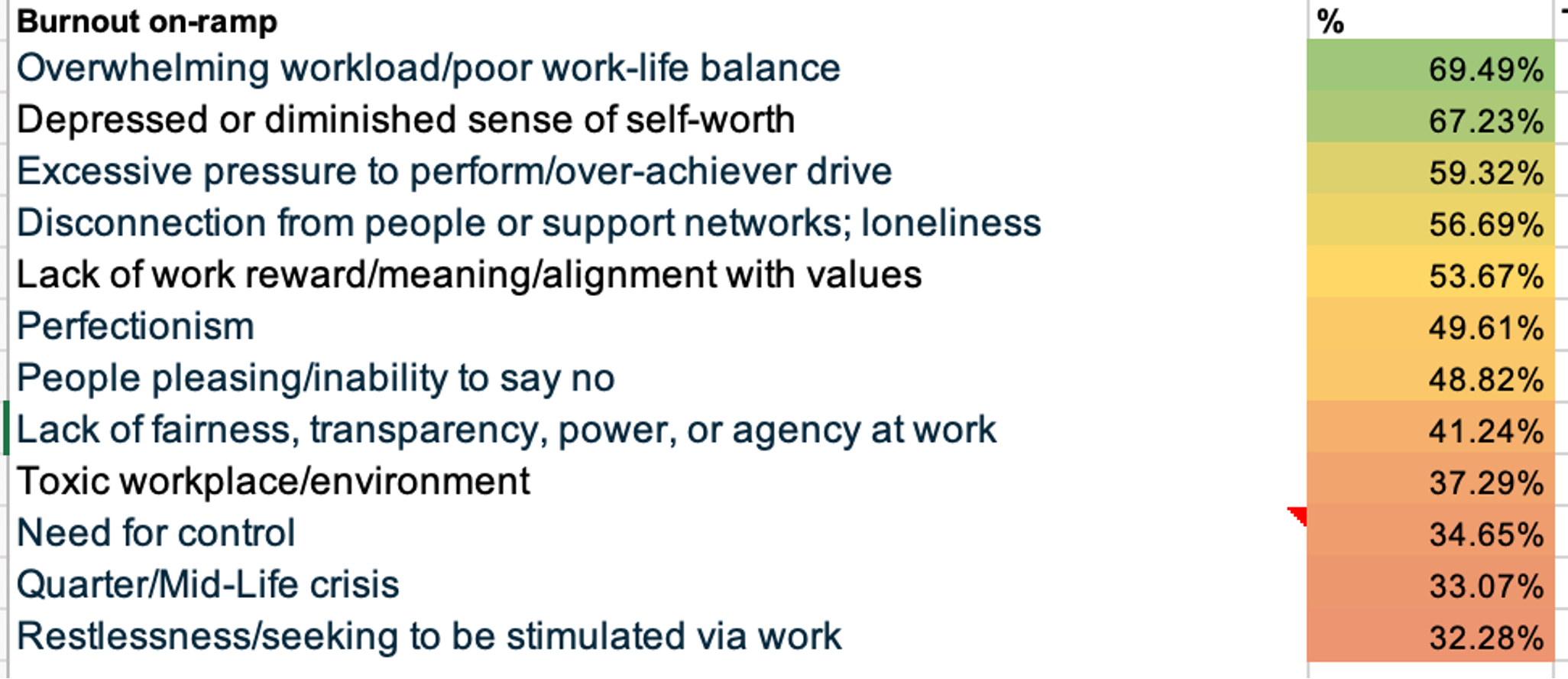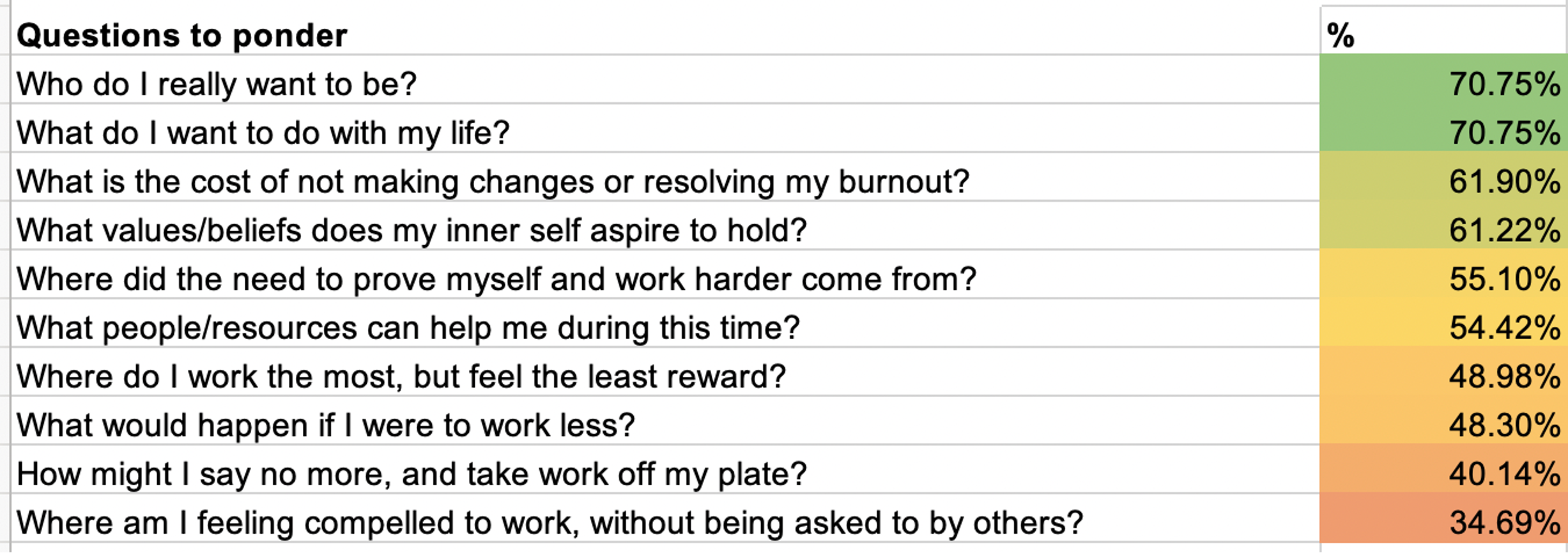Burnout Recovery Research: Survey of over 300 Burnt Out People
Other resources you may like:
Evaluate your life satisfaction (self-assessment)
3-week burnout recovery plan (self-paced guide)
Support the research by taking the survey via the below button or scrolling to the bottom of this page
Have you ever felt like…
There was nothing left to give because you've given so much.
You can no longer "do" without it taking a major hit on your physical and mental health.
You can no longer able to derive pleasure from work-related tasks or accomplishments.
You were so exhausted that everything triggers you and very few things motivate you.
If so, you might have been through, or are currently facing, burnout.
If so, you’re not not alone.
Burnout is recognized by the World Health Organization, and is a collection of symptoms that revolve around the two primary characteristics of exhaustion and disengagement, and which lead to a decreased level of efficacy and productivity at work.
Burnout spans a set of progressively intensifying stages, beginning with a compulsion to prove oneself and including denial of emerging problems, revision of values, and finally depression and risk of physical or mental collapse. Burnout is often discussed in the context of work, but can also occur in parents, caretakers, and other non-work roles.
Having firsthand experienced 10 of the 12 stages of burnout and now through my work as a burnout coach and researcher, I have dedicated myself to the mission of helping others increase their own knowledge of burnout prevention and recovery. As part of this mission, in 2022 I developed a short, confidential burnout survey, which has since been completed by over 200 people and counting. Continue reading to discover an overview of the survey findings, with takeaways.
Burnout measurement benchmarks
While the Maslach Burnout Inventory (MBI) is the “gold standard” for measuring burnout, it is a paid inventory that uses a series of questions to evaluate 3 criteria of burnout (exhaustion, cynicism, decreased efficacy); a free and second most popular alternative is called the Oldenburg Burnout Inventory (OLBI), which also uses a series of questions to evaluate 2 criteria of burnout (disengagement and exhaustion). A higher score indicates a higher likelihood that the respondent is in the midst of a burnout.
While there is no exact threshold which generally indicates whether one is burnt out or not and while trends differ across dimensions such as industry, role, region, etc, the following data anonymously aggregated across 334 respondents shows the average scores from the OLBI (data updated on December 16 2023).
Note: this is not an accurate sampling that is representative of the general population, and is subject to sampling bias of those who have sought out information on burnout.
Average disengagement score: 24.06 out of a possible 32
Average exhaustion score: 25.80 out of a possible 32
You can take the OLBI via the burnout survey to calculate your own score.
Verbatim examples of motivations to recover from burnout
Beginning with some of the reasons why recovering from burnout was important to people, here were some of the most striking and honest:
“I don't want to become depressed/suicidal.”
“I can't go on like this anymore. I want to start living again.”
“Because I want to continue enjoying life and be present with my loved ones.”
“Getting my life back together, clearing up my brainfog, improve my clumsiness”
“I love my job and I want to learn how to participate in it in a more healthy way.”
“I want to feel at my best which is energized, excited by day-to-day life and vibrant.”
“I want to enjoy life again. I'm miserable but I don't want to go up and I don't want this to be all there is.”
“My mental, physical and emotional health matter to me to be a fully functional parent to my 2 children and to lead a more fulfilling life.”
“If I fail to achieve the life I have wanted to live after working so hard I don't know how I can ever find true self confidence again, let alone maintain any self-respect. The dissatisfaction and disappointment would be so overwhelming id probably just find the riskiest way to achieve success and go for it. All-in, no other options.”
Causes of burnout
There are many, many potential causes of burnout, but based on the data, here are the most common from this multi-select, choose as many as apply question. There were not a significant number of custom “other” entries.
Here are some key takeaways:
There was no unanimity in agreement over burnout causes, with no factor earning more than 69% agreement
The top factors leading to burnout are the structure of one’s work and non-work life, expressed via excessive workload and work-life balance*
Given the high rankings of diminished self-worth (2nd) and excessive pressure to perform (3rd), this infers that burnout motivations stem from our attempts to escape our inner insecurities
Disconnection from social networks (which is both a key cause and symptom of burnout) is acknowledged by over half of respondents, inferring that over half of respondents are in the advanced stages of burnout (withdrawal is burnout stage 7 of 12)
Toxic workplace, which is one of the contexts in which burnout is most guaranteed to arise in affected a third of respondents
People are more willing to acknowledge perfectionism, but not need for control which is closely related, likely due to perfectionism being a more societally acceptable than being seen as controlling
*excessive workload and work-life balance have been separated into unique selections in the current survey version
Ways to recover from burnout
Beyond understanding what factors potentially caused a person’s burnout, the survey also explores peoples’ willingness to explore a variety of actionable ways to recover, via two multi-select choose as many as apply questions.
Here are some key takeaways from what changes people are willing to commit to:
The responses seem to represent western society's approach to work, which is not to ask for help, and to do it all on your own, colloquially referred to in the “pull yourself up by your own bootstraps” cliché. This is inferred by A) the top 3 changes that people were willing to commit to, which are independent, self-directed actions that one can do entirely by themselves and B) the low level of willingness to commit to changes that involve interactions or help from others (therapist, coach, manager/colleagues). Furthermore, 2 of the top 3 items call upon the respondent to add more to their plate than they already are doing, rather than cutting back. These norms represent reasons for why burnout is so rampant and what makes recovery difficult or prolonged
A not insignificant percentage of respondents had a willingness to take a break from work (take time off, change job, draw stricter boundaries, sabbatical), which is very positive to see as this is one of the most important parts of recovering from burnout; yet still only half or less of respondents are willing or able to break with work for the good of their recovery. This relates to the chief causes, inferring that people are overwhelmed by work and driven by inner insecurities and the inner saboteur, which all but eliminate working less from the options we believe we have available to us. This is supported by the fact that less than half of respondents considered adjusting their own workload expectations
While they are low in unanimity, two of the most drastic options still were selected by nearly 50% of respondents, in changing job or career (47%), and taking a sabbatical or break from working (40%); this is consistent with the aforementioned conclusion that more than half of respondents are likely in the advanced stages of burnout, where more drastic intervention is needed
Getting enough sleep is a non-negotiable recovery step, so it is a positive sign at two thirds agreement, but also concerning that one third will remain sleep-starved
Twice as many respondents were willing to work with a therapist vs a coach
One third were open to involving colleagues in resolving their burnout
Here are some key takeaways from what questions people are willing to consider, which can help illuminate a path to recovery:
The responses echo the prior question’s findings in being consistent with western society's approach to work: do and grow more, not less. This is inferred from the bottom 4 ranked questions, which all point to working less. Moreover, society’s self-focus was clearly displayed in these results, given that top 2 ranked questions
A positive finding was that many people were willing to consider the cost of burnout (revealing the true cost can increase one’s motivation to recover); yet for some respondents, this conflicts with the lower-ranked willingness to reapproach work and work less
Verbatim examples of questions people wanted answered
The following are some of the questions that were on the minds of people who burned out:
“What first baby steps can I take?”
“How long will it take to recover”
“Will I ever be back to 'normal' again?”
“How to have this conversation with my boss”
“Why do I not do things things I need to do to get healthy.”
“How to let the ship sink at work and be comfortable with the decision.”
“Do some people never recover? After 8 years this is starting to feel permanent”
“How can I reduce these feelings of burnout and get out of fight-or-flight mode”
“Is there any way for me to enjoy life with the constraints and problems of this world?”
“How can I get all the things I need to get done while still working towards my goals without burning out?”
“How do I navigate burn-out recovery while also navigating career transition and self-discovery at the same time?”
“How do you get time to recover from burnout when you don't have a support system and you have bills to pay and 3 children to take care of?”





